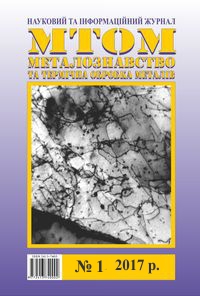Influence of laser treatment on the structure of wheel steel
Keywords:
wheel steel, hardening, laser treatment, plasticityAbstract
Formulation of the problem. The problem of rise of reliability and service life of railway wheels connects not only with elaborate of new constructions of wheels and new steels but also with possibility to use the new methods of strengthening of tread. The goal of work was investigation of influence of laser action on the structure of wheel steel for the possible local strengthening of the zone of cove of railway wheels. Methods. Materials for the study was manufactured wheel steel after hot deformation and heat treatment. Laser pulse radiation processing of wheel steel specimens carried out on installations SES-30M, laser continuous radiation processing of wheel steel specimens carried out on installations LG “Kardamon”. We used research methods - optical microscopy, X-ray, measurement of hardness. Results. It was found that under laser action it is possible to form different structures of wheel steel. Under pulse radiation the laser quenched structures with the type of “white layers” are formed which can to be plasticity under loading. Under continuous radiation the structures of upper and lower bainite are formed which allow not only to rise wear resistance of railway wheels tread but also to reduction of risk of undercut of crests in the time of service. The regimes of heat treatment and laser treatment determine effect of laser strengthening of wheel steel. Scientific novelty. The peculiarities of the structure of wheel steel after different types and regimes of laser treatment was founded. The regimes of laser pulse radiation and laser continuous radiation permiting to receive necessary level of laser strengthening were determined. Practical significance. Using the results obtained enable to develop methods and regimes of laser treatment allowing to strength the zone of cove of railway wheels tread and to reduction of risk of undercut of crests in the time of service.References
Губенко С. И. Физика разрушения сталей вблизи неметаллических включений : монография / С. И. Губенко. − Днепропетровск : НметАУ, ИЦ «Системные технологии», 2014. – 301с. − Режим доступа: https://nmetau.edu.ua /ru/mdiv/i2001/p110
Губенко С. И. Неметаллические включения и прочность сталей. Физические основы прочности сталей : монография / С. И. Губенко. − Германия, Саарбрюкен (Saarbrücken) : LAP LAMBERT. − Palmarium academic publishing, 2015. – 476 с. − Режим доступа: https://www.lap-publishing.com/site/imprint-privacy-policy/13
Деформация металлических материалов : монография / [С. И. Губенко, В. В. Парусов]. – Днепропетровск : АРТ-ПРЕСС, 2006. – 316 с. − Режим доступа: http://www.art-press.com.ua/home
Лазерная поверхностная обработка металлов и сплавов : монография / [П. А. Леонтьев, Н. Т. Чеканов, М. Г. Хан]. – Москва : Металлургия, 1986. – 142 с. − Режим доступа: http://www.metallurgy-publishers.net
Денисенко О. І. Формування поля температур тонкої стрічки під впливом на її поверхню дисперсної фази двофазного струменя / О. І. Денисенко, В. І. Цоцко, І. М. Спиридонова, Б. Г. Пелешенко // Фізика і хімія твердого тіла. – Т. 9. – № 4. – 2008. – С. 901−904. − Режим доступу: http://www.nbuv.gov.ua/old_jrn/natural/phkhtt/2008_1_4/0904-42.pdf
Денисенко О. І. Розподіл температури одновимірного зразка в умовах місцевої термообробки / О. І. Денисенко, В. І. Цоцко, І. М. Спиридонова, Б. Г. Пелешенко // Фізика і хімія твердого тіла. – Т. 9. – № 1. – 2008. – С. 181–184. – Режим доступу: http://www.nbuv.gov.ua/old_jrn/Natural/phkhtt/2008_1_4/0901-29.pdf
Цоцко В. И. Температурные характеристики поверхностного слоя низкоуглеродистых сталей в условиях линейного нагрева поверхности / В. И. Цоцко, А. И. Денисенко // Вісник Дніпропетровського національного університету. – 2004. – № 2. – С. 72–77. – Режим доступа : http://irbis-nbuv.gov.ua/cgi-bin/irbis_nbuv/cgiirbis_64.exe?Z21ID=&I21DBN= UJRN& P21DBN=UJRN1&S21STN=1&S21REF=10&S21FMT=njuu_dstu&C21COM=S&S21CNR=20&S21P01=0&S21P02=0&S21P03=I=&S21COLORTERMS=0&S21STR=%D0%9672605%2F2004%2F3
Цоцко В. И. Аналитическое моделирование поля температур одномерного образца в условиях местной термоциклирующей обработки / В. И. Цоцко, И. М. Спиридонова, Б. И. Пелешенко, А. И. Денисенко // Сучасні проблеми металургії. – Том 10. – Дніпропетровськ : Системні технології, 2007. – С. 170−178. − Режим доступа : http://www.nbuv.gov.ua/old_jrn/natural/Spm/2007_10/15.pdf
Цоцко В. И. Аналитическое моделирование температурного поля одномерного образца в условиях местной термообработки / В. И. Цоцко, И. М. Спиридонова, Б. И. Пелешенко, А. И. Денисенко // Системные технологии. – Вып. 3 (56). – Т. 2. – Днепропетровск, 2008. – С. 22–29. – Режим доступа : http://st.nmetau.edu.ua/journals/56/29_a_ru.pdf
Цоцко В. И. Нестационарное поле температур в металле в условиях импульсного энергетического воздействия / В. И. Цоцко, Б. И. Пелешенко, А. И. Денисенко // Высокоэнергетическая обработка материалов. – Днепропетровск : АРТ-ПРЕСС, 2009. – С. 202–208. – Режим доступа : http://info.donntu.org/el_izdan/geolog/news/35_2010-01-11_9-06-22/fistech09.pdf
Структура и свойства сплавов обработанных излучением лазера : монография / [М. А. Криштал, А. А. Жуков, А. Н. Кокора]. – Москва : Металлургия, 1973. – 192 с. – Режим доступа : http://www.metallurgy-publishers.net
Лазерная и электроннолучевая обработка материалов : справочник // Н. Н. Рыкалин, А. А. Углов, И. В. Зуев, А. Н. Кокора. – Москва : Машиностроение, 1985. – 496с. – Режим доступа : http://www.mashin.ru
Упрочнение деталей лучом лазера : монография / [В. С. Коваленко, Л. Ф. Головко, Г. В. Меркулов, А. И. Стрижак]. – Киев : Техника, 1981. – 131 с. − Режим доступа : http://kiev.glo.ua/marketing/tehnika-specializirovannoe-izdatelstvo-gp.html
Downloads
Published
Issue
Section
License
Authors that are published in this journal agree to follow the conditions:
Authors reserve the right to the authorship of his work and cede the right to the journal of first publication of this work on conditions of the license under the Creative Commons Attribution License, which allows others to distribute it freely with the obligatory reference to the author of the original work and the first publication of the work in this journal.

